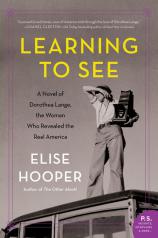Reading Group Guide
Discussion Questions
Learning to See: A Novel of Dorothea Lange, the Woman Who Revealed the Real America

1. Dorothea Lange’s photographs are recognized by many Americans, but few know much about the woman who created the images. How did your understanding of Lange and her art change as you were reading LEARNING TO SEE?
2. In interviews, Dorothea has spoken about how profoundly polio changed her. During the course of her life, she viewed her right foot as both a curse and a gift. Discuss how you see her lameness shaping her relationships, her career and her view of the world.
3. During the early 1900s, laws to ensure safety, education, health and care for children were still evolving into the many protections that exist now. Dorothea’s decision to foster her children out to another family during the 1930s often stuns people today. It also caused a long-standing rift between her and Dan and John. Discuss her reasons for making this choice. Do you empathize with Dorothea’s actions? How do you feel about Dan’s reactions?
4. People who knew Dorothea well often describe her as difficult and controlling. Do you think that this is merited or an unfair characterization? What adjectives would you use to describe her?
5. Dorothea Lange was a trailblazing woman artist at a time when the art world was dominated by men. How did she navigate the complexities of these relationships and build a successful career? Are these challenges still relevant today?
6. Dorothea enjoys some important friendships with other women over the course of her life, including Fronsie Ahlstrom, Imogen Cunningham, Consuelo Konaga and Frida Kahlo. Reflect on how these relationships impacted her.
7. Before traveling with Paul Taylor, Dorothea had almost no experience with rural life. Discuss the many ways how her exposure to farmers and agriculture caused her views to change.
8. Dorothea’s relationships with Maynard and Paul reveal very different dynamics. In some ways both marriages reveal many gender role expectations of the 1920s and ‘30s, and in other ways the marriages defy conventions of the time. Discuss how the men she loved shaped how she viewed herself.
9. When Maynard and Dorothea end their marriage, he asks her if she thinks they would have stayed together if not for the Great Depression. How did extreme economic downturn affect their relationship? Do you think their marriage would have survived during more stable, happier times?
10. Many of Dorothea’s photographs are available to be viewed through the National Archives. After you spend some time looking at them, which of her photographs appeal to you the most? Why? Before reading this novel, do you think you would have selected a different one?
Learning to See: A Novel of Dorothea Lange, the Woman Who Revealed the Real America
- Publication Date: January 22, 2019
- Genres: Fiction, Historical Fiction
- Paperback: 384 pages
- Publisher: William Morrow Paperbacks
- ISBN-10: 0062686534
- ISBN-13: 9780062686534







